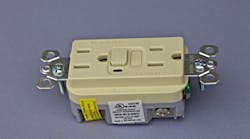Ground fault circuit interrupter (GFCI) receptacles protect people by opening the circuit when L-N current exceeds (typically) 4mA to 6mA. You’ll find GFCI requirements in various places throughout the Code; the 2017 NEC index shows about four dozen entries. Here are three GFCI myths:
- They need a ground wire to work, so you can’t use them on older 2-wire circuits.
Fact: The sensing function uses the hot and the neutral. If using on a 2-wire circuit, affix a label stating the receptacle is ungrounded. - All GFCIs are the same, get the cheapest one.
Fact: Look for GFCIs with features like a wiring error indicator light or no reset if a wiring error. - If you wire bathroom circuits, you must put the GFCI in the first bathroom (from the breaker) in the circuit.
Fact: You can improve user convenience by installing a GFCI in each bathroom. Wire so each bathroom feeds the next, connecting the load wires to the bottom set of hot terminals until you get to the last GFCI. Then wire the last GFCI to protect its downstream loads.




